
Gundam Breaker 4 Review
It’s been tough being a Gundam Breaker fan. Nearly a decade after the release of the remarkable Gundam Breaker 3, the series’ trajectory plummeted with the abysmal New Gundam Breaker quasi-reboot and the now-defunct Gundam Breaker Mobile gacha game. After the mobile game shut down, I was convinced that the Gundam Breaker series was finally laid to rest permanently - riding into the sunset with the wallets of gambling addicts in hand.
Then, out of nowhere, Bandai Namco announced Gundam Breaker 4 at a Nintendo Direct earlier this year. I was genuinely shocked, especially by their deliberate naming convention to title it Gundam Breaker 4 and not New Gundam Breaker 2. Every step of its marketing cycle emphasized that this was a proper follow-up to the main series, and not trying to awkwardly reinvent the wheel, so the developers did their best to distance themselves from the New Gundam Breaker disaster by not mentioning it ever again.
As someone who first got into the series with Gundam Breaker 2 and sunk a gigantic amount of time into Gundam Breaker 3, I come away from Gundam Breaker 4 feeling satisfied in some ways and let down in others. The gameplay loop is certainly a course correction back to what Gundam Breaker 2 and 3 established, but several severe shortcomings prevent it from achieving greatness.

Players are plunged into the in-universe beta phase of GUNPLA Battle Blaze: Beyond Borders (which the game refers to as GB4) right at the start. It’s a Phantasy Star Online-esque evolution of the ongoing technology in the series’ world that allows players to scan their gunpla model kits into virtual space. Back in Gundam Breaker 3, this concept needed large arcades to operate it, but as time went on and the technology advanced rapidly, people in the Gundam Breaker universe could now do this from their own devices at any time. Obviously, it parallels how our reality’s video game technology has progressed over the last four decades.
Gundam Breaker 4 is set several years after the events of Gundam Breaker 3, Gundam Breaker Mobile, and the Gundam Breaker Battlogue anime series in this regard. Although they all share the same world, the main story of Gundam Breaker 4 is isolated enough that series newcomers will fit right in. There are a few returning characters with cameo appearances and small moments that veterans will enjoy, though.
The story quickly introduces a few starting companions through Tao and Lin, who are also both relatively new to the GB4 open beta. Eventually, the trio decides to form a clan and recruit several other characters along the way to participate in some of the events held in the GB4 beta. There are a few deeper mysteries established early on that I won’t get into, but the main story of Gundam Breaker 4 oddly resembles the narrative found in the dot hack series at times. Game characters will even send in-game emails to players from time to time, yet sadly no in-game forum like the pseudo-MMO franchise.
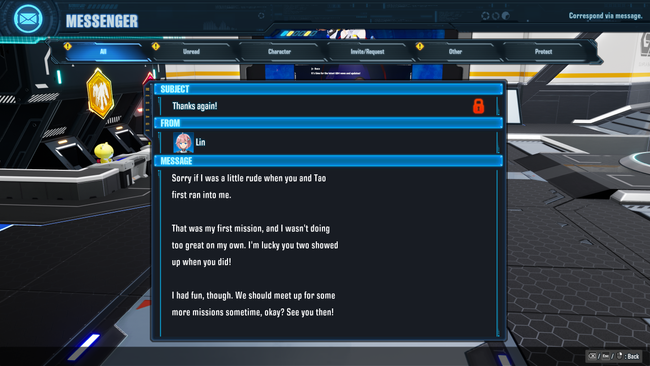
While it isn’t anything stellar, the main story is serviceable and enjoyable enough. Each of the members that join the protagonist’s clan receives a minor development arc at the very least. Out of curiosity, I played through it all with English voices and the cast did a solid job bringing out the personality of each character in a natural manner.
One of the biggest weaknesses in Gundam Breaker 4 is the incredibly repetitive stage design taken from Gundam Breaker Mobile. Every single stage, whether it’s from the main story or an optional quest, consists of fighting off enemy waves in a closed-off environment and getting teleported to the next one doing the same thing again before fighting the main enemy team or gigantic boss in the final area to complete the stage. The only slight variations from this structure come occasionally when you have to defend a shuttle or destroy a monolith to proceed.
While prior entries also had people fight off enemy waves, a sense of spatial progression was maintained by having players navigate through a map into the next zone. There was also consistent environmental theming to the stages most of the time, whereas Gundam Breaker 4 often feels like it’s throwing players into a random zone - the first area might be in a city and then all of a sudden you’re inside of a volcano. A few of the later environments in the main story do bring in some new scenery, but after a while, it all just blurred together for me. I think this is one of the most severe missteps that Gundam Breaker 4 commits.
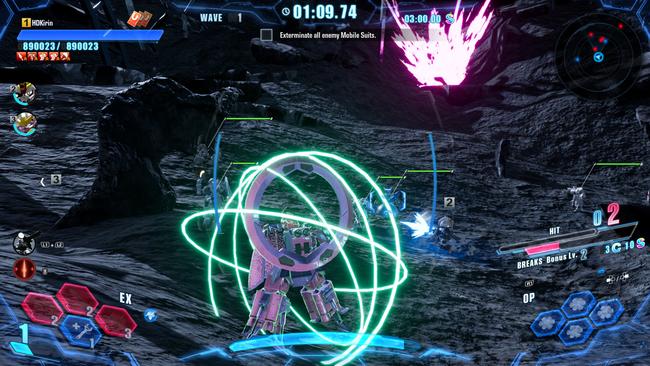
In an ironic twist, the single collaboration stage Gundam Breaker 4 has with Pac-Man shows a glimpse of how the developers could have introduced any type of variety to the formula. That stage cleverly emulates the iconic game’s ebb and flow by having invincible enemies chase the players through a maze; people have to pick up a certain power-up to make their pursuers vulnerable to damage for a limited amount of time as they traverse through the labyrinth collecting pellets to move on.
Thankfully, Gundam Breaker 4 excels in one of the core fundamental pillars that has made the series special - the gunpla-building experience. As people progress through stages, they’ll encounter Mobile Suits from a plethora of different Gundam series. Gundam Breaker 4 roughly contains over 250 kits, which is the largest starting roster any of the console entries have had at launch before any post-launch DLC entered the fray. Any foe encountered has the potential to drop some of their parts for players to use.
If a stage is being stingy and not dropping a desired Mobile Suit’s part, players can always visit the shop at the lobby to purchase that gunpla’s kit to receive all of their parts immediately. However, while purchased parts start at level 1 at the lowest rarity, there are resources I’ll go into later that can quickly get them up to speed.
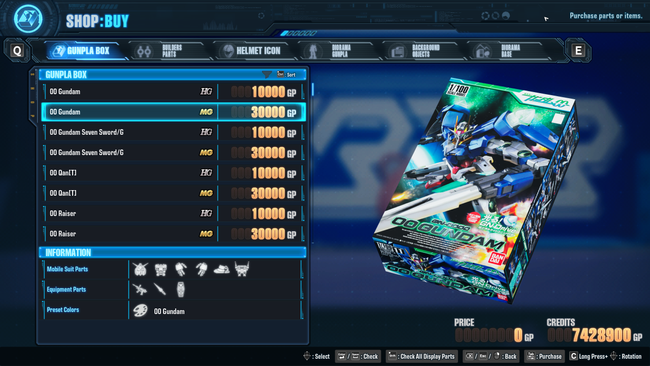
People can reconstruct their favorite Mobile Suits faithfully by matching all of their parts together, or go absolutely buckwild kitbashing, mixing together parts from multiple different gunpla. Gundam Breaker 4 gives an unprecedented amount of freedom in building this time around, as players can customize a gunpla’s head, body, left arm, right arm, legs, backpack, different long-ranged weapons per arm, different close-ranged weapons per arm, shield, up to eight different Builders Parts accessories, and tweaking all the skills it’s capable of firing off in combat.
The most significant change that returning series players will notice right away is that both the left and right arms can now each be distinctly different from one another, and that almost every weapon type can be dual-wielded together. There are two attack buttons, but now they correspond to either attacking with the left or right arm’s weapon. Only certain two-handed weapon types, such as the greatsword and melee weapon types, retain the traditional light and heavy control scheme from previous installments.
This feeds into some new system mechanics in Gundam Breaker 4’s battle system. As people begin their gunpla onslaught, they’ll notice two huge meters at the right side of their screen, the Hit and Break gauges. The former is raised by continually landing hits on foes, while the latter depends on consistently breaking enemy parts off. When either of the two gauges are filled, they level up and grant temporary bonuses to players; leveling up the Hit gauge gives buffs, and leveling up the Break gauge increases the drop rate of parts.
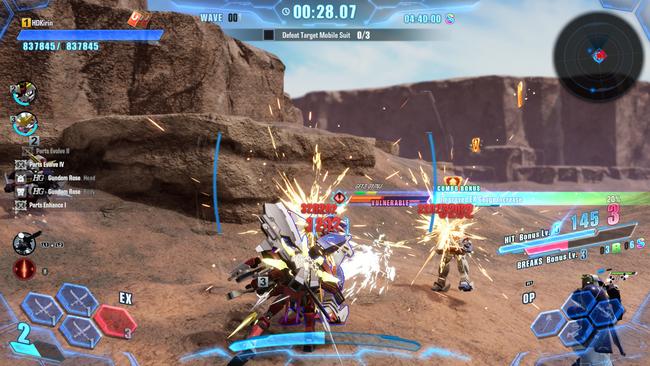
Weapon types, in return, supplement these two gauges by specializing in raising the Hit or Break gauge more easily. Axes and maces, for instance, have a better tendency to break off parts, but lances and fencing sabers have multi-hit chain attacks to maintain the Hit gauge easily.
On paper, this sounded restrictive at first, because it seemed like I was being goaded into picking two weapon types out of necessity to properly maintain the two gauges rather than having complete control over what I preferred. In reality, it didn’t really matter as long as I kept a steady cadence of damage, since defeating an enemy or taking off a lifebar from bosses still counts as a Break, while connecting hits with ranged weapons can keep the Hit gauge at bay.
Though I appreciate the developers trying some new ideas with Gundam Breaker 4 here, I wish they also had a “two-handed” variation for every weapon type. By confining most categories of weapons to a one-handed stance, their moveset feels diluted as a result. They have a standard attack combo string, a “heavy” attack by holding down the attack button, and a move that activates when a person switches weapons in the middle of a combo. It’s not a bad idea conceptually, yet it lacks variety and loses a bit of the unique identity some weapon types had in Gundam Breaker 3.
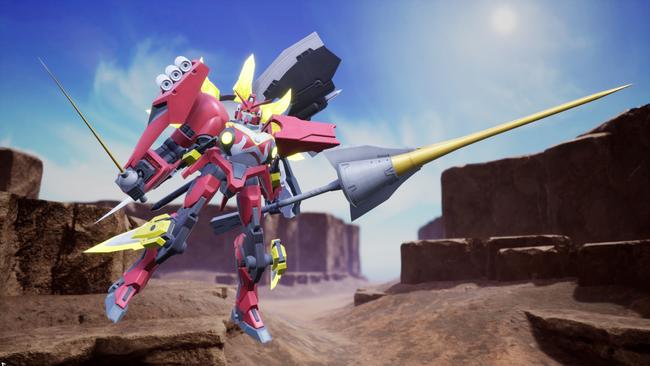
Despite these issues I have with this new installment of Gundam Breaker, it makes some smart user experience adjustments that remarkably improve some of the cumbersome elements in previous entries. When tweaking and perfecting a gunpla, people can immediately launch a training mode right from the assembly menu to test out how a part, weapon, or skill is performing; they no longer have to boot up a stage for five seconds to check something real fast.
Each individual part of a gunpla, aside from its weapons, can now be individually resized and rescaled. This rectifies a long-standing problem of High Grade (HG) and Master Grade (MG) sized parts looking mismatched because they were limited to their different sizes innately. Plus, Gundam Breaker 4 now allows people to mix in SD Gundam parts with any of the other size classes, so the sky's the limit when it comes to what sorts of models people can create. Naturally, the incredibly in-depth paint system remains intact and includes even more additional options now as it gives people more control over each part’s panel lines.
There is no longer a statistical penalty between HG and MG parts, as well. Usually, in prior Gundam Breaker entries, MG parts would arbitrarily be better because they would be unlocked further into the game and I suppose their bigger scale warranted better stats. A body part in Gundam Breaker 3 that both had its HG and MG counterpart in the game would share identical stats but since MGs had a higher level cap, they would universally be better when fully upgraded over their HG.
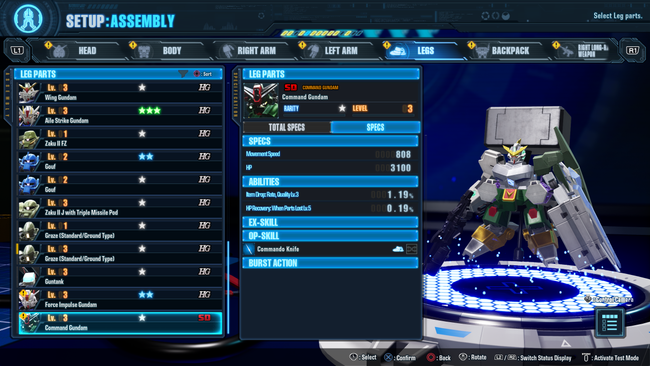
All parts now, regardless of their scale or type, share the same level cap and standardized stats. A HG Zeta Gundam head’s stats at level 50 will share the same stats as a MG Zeta Gundam head and the MG cannot go past level 50. Thus, the only significant difference between the two identical parts is cosmetic; since a MG part is inherently bigger, it can be scaled to a larger max size visually than a HG.
After progressing through certain sections in the main story, people will eventually unlock more ways to enhance parts. They’ll start obtaining items that allow them to increase the level and rarity of any part; levels increase a part’s individual stats, while rarity unlocks more ability slots. Players can eventually merge other parts into their equipped part to manually transfer over which abilities they want from them.
Let’s say that I want a gunpla to have Epyon’s legs, but it currently has several abilities I don’t want on it, such as thruster capacity and recovery speed. Instead, I want the increased HP capacity and movement speed of a Wing Gundam’s legs; all I’d have to do is merge that Wing Gundam into my Epyon and swap out those abilities freely.
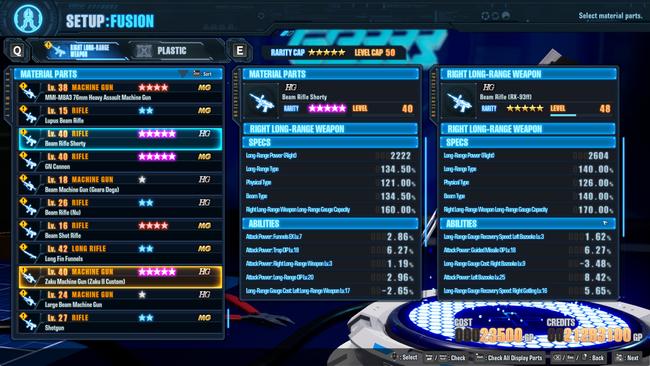
It’s a fairly easy process, though learning the language of how some of the abilities are phrased is a bit of a learning process. What does ‘Attack Power: Throw OP Lv. 9’, ‘Max Duration: Break Combo Lv. 17’, or ‘Extended Activation: Hyper Trance EX Lv. 9’ mean? With enough trial and error, it begins to make sense and the game sadly does not provide tooltips to give a detailed breakdown for many of its awkward word salad abilities. Still, it is a smidge better than how Gundam Breaker 3 handled it, because that game had players fiddle around with merging higher-tier color rarities to advance their chosen part to the next tier, while Gundam Breaker 4 streamlines it all into plastic item pieces designed to either advance the separate rarity or level bars.
Of course, a lot of the fun in designing a custom gunpla in the Gundam Breaker games stems from what sorts of skills it can fire off in the middle of combat. Many of my part decisions early on in Gundam Breaker 4 were dictated by what kind of EX or Option (OP) skills they had on them. If I wanted funnels, I probably leaned more toward using a Nu Gundam’s backpack or a Cherudim Gundam’s arm to access its shield bits. Perhaps I wanted my model kit to boost its capabilities temporarily, so I bolted on a part from a Unicorn Gundam or Banshee Norn that possessed the NT-D EX skill.
Designing a gunpla solely based on the capabilities of parts doesn’t sound like that much fun in the long run, though. After all, there are a myriad of parts that don’t have a single EX or OP skill attached to them. This is where Master Skills come into play.
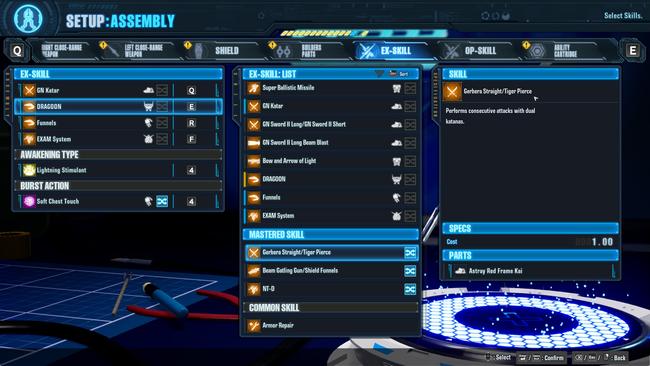
When a player fully maxes the rarity of a part, all of its unique skills will be converted to Master Skills. This now allows those skills to be slotted into any gunpla build universally, regardless of whether the part is equipped or not. Once I was drowning in rarity evolution plastic pieces from higher difficulty stage runs, I began to invest in expanding my pool of Master Skills by maxing out the rarities of parts left and right.
Unfortunately, I think Gundam Breaker 4’s skills feel more akin to how New Gundam Breaker handled them. They’re more visually reserved and subdued compared to how flashy and over-exaggerated the animations were for them in past mainline games. Instead of an extended sequence of flashy katana strikes before an air launcher into a spinning helmbreaker finish from a single EX skill, Gundam Breaker 4 opts for a quicker 5-hit katana combo with more simple action choreography. That doesn’t mean there are no cool or fun skills at all to mess around with, though it’s hard to dismiss how less over-the-top the skill animations are across the board.
Action economy, resources, and allocation for EX and OP skills have seen some major revamps. The four EX skills a player equips no longer go on an individual cooldown per skill activation. Now, EX skills share a universal EX meter that works a lot like a fighting game’s super bar; people can build up to a max of 9 EX bars and EX skills can consume 1, 2, or 3 EX bars. There is no cooldown on when they can be activated again, so people can constantly fire off EX skills if they’re able to fill up the EX meter quickly.
OP skills, on the other hand, are well… they’re only activatable skills now, unlike having entire optional equipment with their distinct option attack movesets. They operate with traditional cooldowns upon individually using them and up to eight of them can be equipped. The main change with OP skills is how certain weapon types, such as funnels, are exclusive to EX skills; there are no longer any funnels available as OP skills. Health recovery skills are in a similar situation as well, though passive HP recovery and lifesteal are still abilities that can be installed onto parts. Skill cooldown reduction for OP parts can be a very valuable ability modifier to stack, since gunpla movesets focusing on how fast OP parts can be fired off are achievable and viable still.
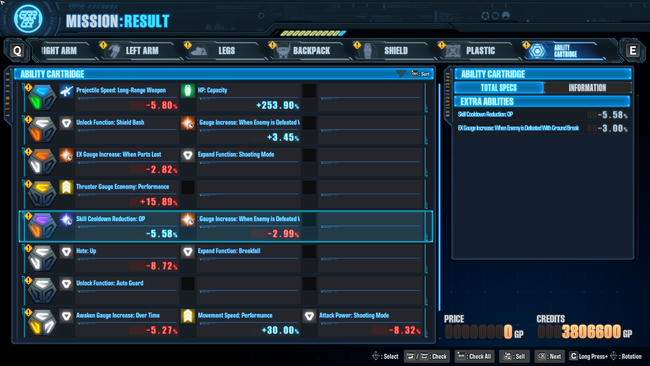
A fun wrinkle that feeds into the action RPG grind is the new Expansion Ability Cartridge mechanic. After a certain point in the main story, stages will begin to drop Ability Cartridges which randomly roll up to three abilities on them that can be both beneficial or detrimental to a gunpla’s build. For example, a random Ability Cartridge drop may add an astounding 253% to HP capacity at the cost of also incurring a 6% penalty to the projectile speed of ranged weapons. Cartridges may also unlock new functions, such as auto guarding which will have a gunpla automatically block whenever possible at all times.
Earlier, I compared the new in-game GB4 program inside Gundam Breaker 4 to Phantasy Star Online. This is most apparent in its main menu lobbies that support up to 24 people online, while parties of up to 3 people can play through stages together. I only got to test the online functionality briefly during a limited-time open network test on the PS5, since the online servers were disabled in my PC review copy on Steam.
While it’s a bit of a bummer that the game doesn’t support cross-play across platforms, I hope there’s a healthy community of players that embrace the more shared social-facing nature of the lobby system though of course, people can make their lobbies private at any time. I’m definitely sneaking into some public lobbies to see what sorts of monstrosities people are going to build.
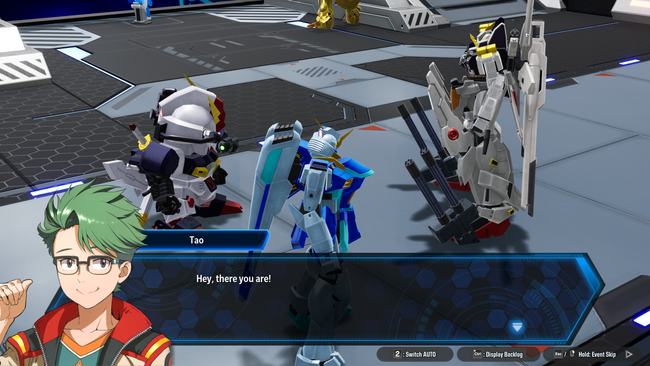
An even more fascinating feature that I didn’t get to try out because I couldn’t connect to the online server during the review period is the clan system. In Gundam Breaker 4, it is possible to form an online clan, though I’m not sure what the player cap is for a clan. I’m not exactly sure if Bandai Namco plans to have post-launch events that involve the clan system in any sort of meaningful way. What I do know is that members in clans gain access to an Item Box after completing the main campaign, in which they can give or trade stuff with other members of the clan through depositing and retrieving items from the clan’s Item Box. Once again, I couldn’t try this feature out for myself and only learned this through tutorial pop-up messages.
Speaking of the PC version, I’m happy to report that Gundam Breaker 4 ran beautifully on my PC set-up. It supports high framerates and cranking up all of its settings to max made it look considerably better than what I saw of it on my PS5. The only small stutters I noticed were some map environments in the later stages of survival mode. Other than that, it ran absolutely fine on my end but then again, I have a GeForce RTX 3080, so I would hope so. There are a lot of PC options and settings that can be tweaked so I’m optimistic that it’ll be fine for most people and not just me.
Another major component is the new Diorama mode, which is another rabbit hole that creatives can spend dozens upon dozens of hours with. This provides an extremely extensive toolkit to build model sets with fully-featured environmental flourishes. It’s like digging into a massive toy box to either recreate memorable scenes from a Gundam show, remixing iconic moments with fun ‘what-if’ scenarios, or entirely building something new from scratch. The amount of control, right down to freeze-framing a specific animation frame of a given motion, is incredible and I imagine this mode alone will cause certain people to sink hundreds of hours into Gundam Breaker 4. Whether it’s through a diorama masterpiece or the more standard photography mode, people can freely upload their screenshots into an in-game collective gallery where people can browse and like the creations of others.
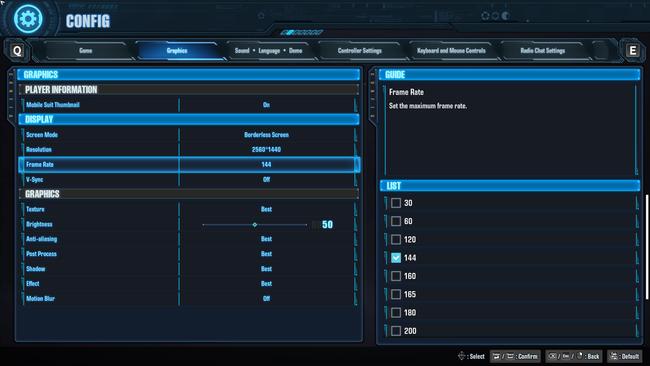
Gundam Breaker 4 is like watching an old friend rebound from tough times. It may not be as great as its mainline predecessors in some regards, but it is a solid course correction from the last few dire entries. The repetitive stages and diluted weapon options are a noticeable step back, yet so many quality-of-life improvements to this new entry in the gunpla action RPG series make it much a smoother experience to play. While completing the main story took me roughly around 17 hours, I'm just about to reach the 60 hour mark because I keep making entire new gunpla builds to take on the highest difficulty stages on their own. It takes virtual model kit building to the next level and the potential of crafting something truly masterful, or horrific, is only limited by a person’s imagination.